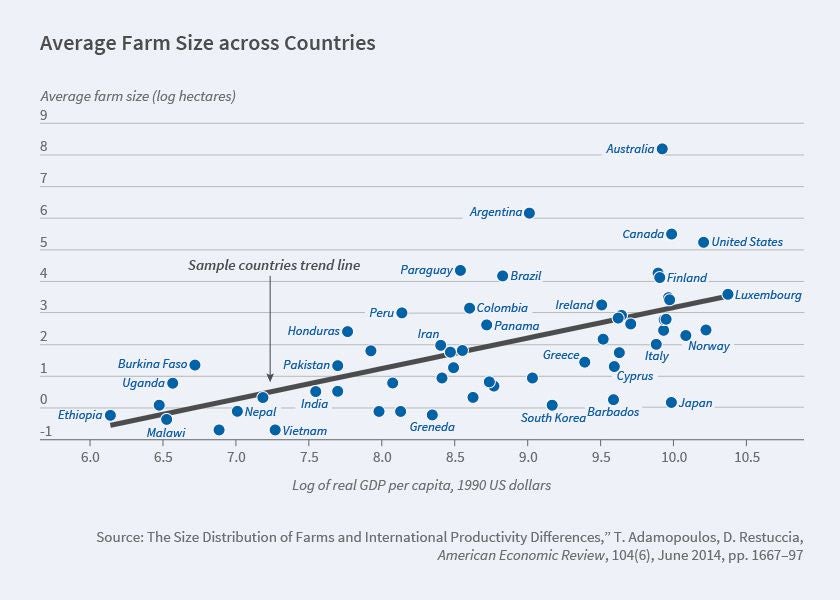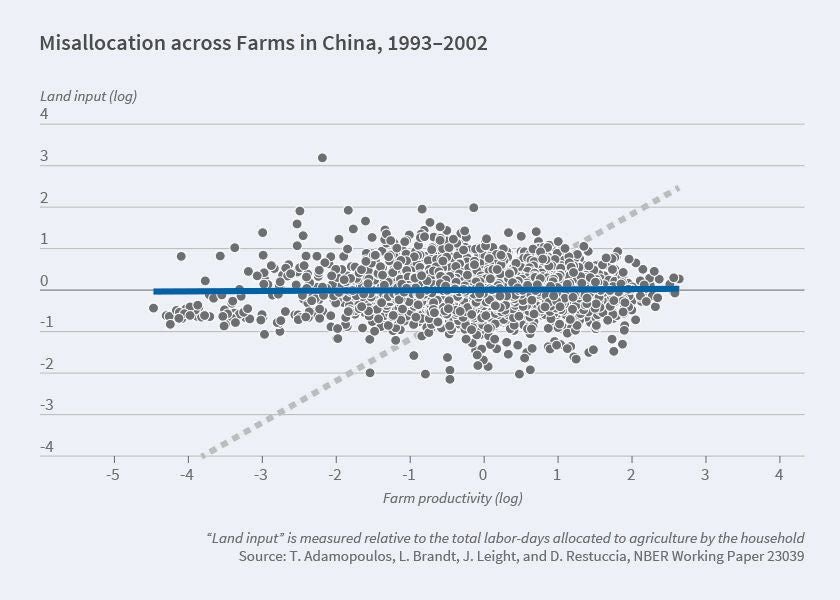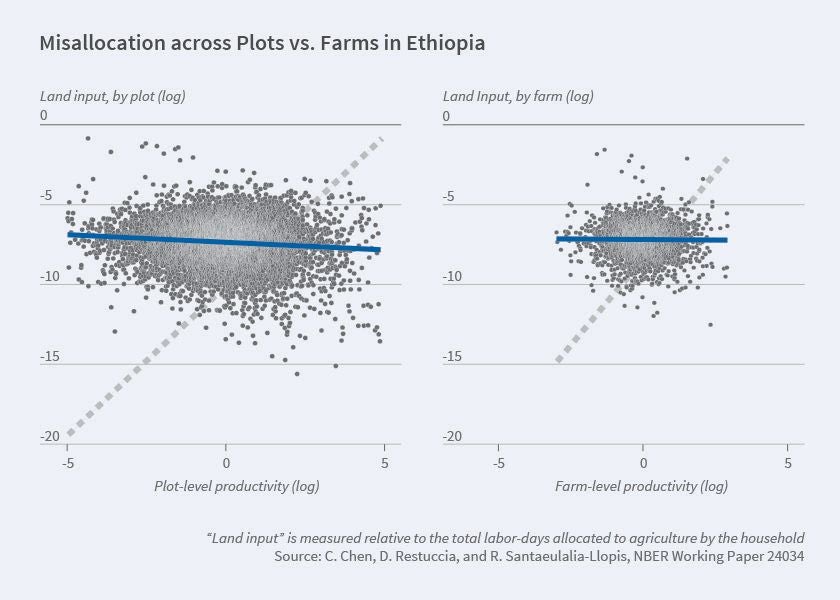The Impact of Land Institutions and Misallocation on Agricultural Productivity
Differences in agricultural systems are highly relevant to the large income differences between rich and poor countries. There are two complementary reasons for this: poor countries are much less productive in agriculture than in the rest of the economy when compared with rich countries, and poor countries allocate most of their labor to agriculture. Whereas in rich countries less than 5 percent of the labor force works in agriculture, more than 70 percent is employed there in poor countries. At the same time, the disparity between rich and poor countries in real labor productivity is more than 35-fold in agriculture, while less than fivefold in non-agricultural sectors.1
Because low productivity constrains more labor to be engaged in agriculture in order to meet subsistence food constraints, the key question is: what are the fundamental reasons for low productivity in agriculture in poor countries? Since measured factor inputs, such as land endowments or quality, physical capital, and intermediates, among others, do not account for much of the productivity disparity across countries, the challenge is to determine what other factors may be relevant.2
An important development in the macroeconomics literature has been the recognition that production takes place among heterogeneous production units and that resource misallocation across these units can matter for aggregate outcomes.3 This insight has given relevance to many policies and institutions that affect resource allocation even if their influence cannot be detected from aggregate data. Consider, for instance, a regulation that on paper applies to all establishments but is effectively only enforced on large, more-productive producers, creating idiosyncratic effects across producers and hence misallocation; or the level of financial development that is common to all producers but may effectively constrain more-productive producers who want to expand.
There is ample evidence that policies and institutions that have idiosyncratic effects across producers are prevalent in the agricultural sector in poor and developing countries.4 Many of these policies tend to favor smallholder production systems; they include subsidized credit and intermediate inputs directed toward small or poor farm households. As a result, a symptom of low productivity in agriculture in poor countries is the prevalence of small-scale farming. Figure 1 shows the striking differences in average farm size between rich and poor countries.
Evidence of Misallocation
Is there evidence of misallocation in agriculture in poor and developing countries, and if so does it matter? To interpret the evidence from farm-level data, consider the situation in which a homogeneous agricultural good is produced by a set of heterogeneous farms that differ in their total factor productivity (TFP). Farm production features decreasing returns to variable inputs such as land, capital, labor, and intermediates. As a result, it would not be optimal to allocate all inputs to the most productive farm. This simple structure generates a non-degenerate farm-size distribution based on productivity differences. In the absence of any market imperfections or distortions, aggregate output and productivity are maximized when factors of production are allocated in proportion to farm productivity; that is, more productive farms are larger and farms of the same productivity operate at the same scale. Importantly, any deviation from this allocation would lower agricultural productivity, even if allocating more resources to farms with higher productivity. A key insight is that a weak correlation of farm inputs and farm productivity is indicative of misallocation.
Measuring farm TFP requires detailed microdata and is subject to several relevant measurement issues. Fortunately, high-quality microdata are available for many poor and developing countries. One such data source for many countries in Africa is the Living Standards Management Study-Integrated Survey of Agriculture (LSMS-ISA), developed by the Gates Foundation and collected by the World Bank. Households are asked about all their agricultural outputs and inputs into farm production, with detailed information about the land operated by the household, including in some cases land quality characteristics. Using these data, farm-level productivity can be estimated or measured using a specific production function.5
Despite differences in institutional detail and data quality, the overwhelming finding is that in poor and developing countries, farm inputs are not strongly associated with farm productivity. In most cases there is no systematic relationship between farmland input and farm productivity, contrary to the strong association that arises in an efficient allocation and in observed allocations in developed countries.
Consider for instance the allocation of land in farms in China, as documented in Figure 2. Whereas an efficient allocation would require a strong association between farm TFP and land input (as illustrated by the light grey line), the actual allocation of land in farms in China (dots) is, on average, essentially flat with respect to productivity (dark blue line). In this specific context, if land and other complementary inputs were reallocated to best uses, agricultural productivity could increase by 24 percent within villages and up to 53 percent if resources could also be reallocated across villages.6 These are large productivity increases just from static reallocation. The same pattern of land misallocation arises in many other countries, such as Malawi, Ethiopia, Uganda, and others.
Connecting Misallocation with Land Institutions
The finding of substantial land misallocation should not be surprising, given the institutional context in which land allocations take place in many poor and developing countries. Consider for example the prevalent form of land rights in Africa — communal land rights — where ownership resides with the state or the commune, and rural households are allocated land-use rights on a fairly egalitarian basis. This is the case in Malawi and Ethiopia. Or consider the allocation of land under the household responsibility system in China — a component of the hukou system — where households are allocated land-use rights by village officials to provide an equitable distribution of land among households in the village. Even though rentals of land are not prohibited in China, frequent land reallocations to accommodate changes in demographics have likely contributed to the implicit “use-it-or-lose-it” rules that have prevented any substantial rental activity to disassociate the distribution of use rights from farm operational scales.
A direct approach to assessing the role of misallocation arising from restrictive land institutions is to study how variations in these institutions over time and space have affected agricultural productivity. Tasso Adamopoulos and I study a comprehensive land reform in the Philippines that imposed a maximum farm-size ceiling and redistributed excess land to the landless and smallholders.7 This land reform substantially reduced both average farm size and agricultural productivity. Most of the negative productivity effects arise because of the government’s intervention in the redistribution of above-ceiling lands. A market reallocation would have generated only one-third as large a productivity loss. Lax enforcement of the farm ceiling prevented the productivity losses from being substantially larger.
Another reform case comes from Ethiopia, where land is owned by the state and land sales are prohibited by law. Ethiopia implemented an ambitious land-certification program of use rights intended to provide stronger tenure security to farmers. The program, however, has to various degrees allowed land rentals to separate assigned land rights from land use. The reform was decentralized across regions with different timing, creating relevant variation in land rental activity across space and time. This context permits studying the effects of land rentals on misallocation and productivity.8 The overwhelming finding both empirically and through a quantitative model is that increased land rental market activity has a significant positive effect on agricultural productivity.
Relevance of Measurement Error and Other Issues
Quantifying the effects of misallocation in agriculture relies on measures of productivity at the production unit level. There are important reasons to be concerned with measurement issues, which are likely to be present in survey data, but the key question is whether these issues alter the big picture of misallocation that emerges. I argue that it does not. In all the studies mentioned above, the unit of analysis is the farm household and not an individual plot operated by a household. In agriculture this distinction is important, since it is common for households in the developing world to operate several plots of land. In Ethiopia, for example, households operate seven plots on average. The farm is the relevant unit of analysis in this context for two reasons. First, measuring productivity at the plot level is challenging because some inputs are shared across plots, inputs and output measures may be subject to measurement and reporting errors, and reported output may depend on shocks that are difficult to control in survey data, to list just a few issues. Aggregating all plot level data to the farm level can mitigate these potential measurement issues. Second, the institutional allocation of land is based on farm households.
The distinction between the plot and the farm matters for assessing the cost of misallocation but not for the pattern of misallocation that emerges. Consider, for example, the microdata from Ethiopia. Dispersion in productivity and distortions are both much higher at the plot than at the farm level, implying reallocation gains that are almost four times larger at the plot than at the farm level. But while the cost of misallocation varies, in both cases there is hardly any association of land input with farm TFP. This is shown in Figure 3; it is precisely the evidence of misallocation discussed earlier.
The distinction between the plot and the farm is also relevant when comparing with measurement error in other sectors. A plant in the manufacturing sector compares more closely with a plot in the agricultural sector, with the distinction that most businesses operate a single plant. Plant-level data can exhibit substantial measurement error.9 Instead, farm-level data from China indicate a much smaller degree of measurement error.
Misallocation and the Inverse Farm Size-Productivity Relationship
A negative relationship between farm size and land productivity or yield is a well-established empirical fact in development economics. There are at least two possible interpretations of this fact. The conventional interpretation is that small farms are more productive than large farms and, hence, efficiency and food availability would be enhanced by redistributing factors toward small-scale farming. This interpretation has had an enormous influence on development policy.
Another interpretation is that differences in land productivity reflect in part misallocation. Detailed farm-level data from Uganda indicate that while farm size is negatively related to land productivity, consistent with the empirical fact, it is positively related to estimated farm TFP.10 The negative size-yield relationship becomes positive when accounting for misallocation and key features of the farm production function. The role of misallocation can also be assessed by comparing regions in Uganda with sharply different land tenure regimes: the customary land tenure regime based on communal land in the north/east region and the more modern non-customary land tenure regime in the central/west region. Misallocation is higher and there is a stronger negative size-yield relationship under communal land allocation.
More generally, how useful is the inverse farm size-productivity relationship? In the case of Uganda and other poor and developing countries, there is as much dispersion in farm productivity within a farm-size class as across the entire distribution of farms. As a result, because of distortions in the agricultural sector in poor countries, farm size is not a useful instrument for policy implementation. An important general insight of the misallocation literature is that distortions deeply confound the relationship between establishment size and productivity.
Broader Implications
The misallocation approach generates several broad implications. For instance, it is often argued that an egalitarian distribution of land rights is effective at redistributing income. However, the evidence is that the inability of households to reallocate land-use rights sustains large income inequality, since the return to land reflects differential farming ability. An alternative allocation of resources can achieve substantial gains in agricultural productivity and at the same time reduce inequality. Another implication is that restrictive land markets tend to disproportionally affect the more able farmers, who would like to expand or choose instead to work outside agriculture. These effects can further reduce agricultural productivity by disincentivizing the use and adoption of modern technologies in agriculture and by distorting occupational selection. Secure land rights are not sufficient to generate a better allocation of resources and growth if land cannot be reallocated across households, potentially explaining the failure of many reforms emphasizing only secure rights.
Endnotes
“Agriculture and Aggregate Productivity: A Quantitative Cross-Country Analysis,” Restuccia D, Yang D, Zhu X. Journal of Monetary Economics 55(2), March 2008, pp. 234–250.
“Geography and Agricultural Productivity: Cross-Country Evidence from Micro Plot-Level Data,” Adamopoulos T, Restuccia D. NBER Working Paper 24532, April 2018.
“Policy Distortions and Aggregate Productivity with Heterogeneous Establishments,” Restuccia D, Rogerson R. NBER Working Paper 13018, April 2007, and Review of Economic Dynamics 11(4), pp. 707-720; “The Causes and Costs of Misallocation,” Restuccia D, Rogerson R. NBER Working Paper 23422, May 2017, and Journal of Economic Perspectives 31(3), Summer 2017, pp. 151–174.
“The Size Distribution of Farms and International Productivity Differences,” Adamopoulos T, Restuccia D. American Economic Review 104(6), June 2014, pp. 1667–1697.
“Land Misallocation and Productivity,” Restuccia D, Santaeulalia-Llopis R. NBER Working Paper 23128, February 2017.
“Misallocation, Selection, and Productivity: A Quantitative Analysis with Panel Data from China,” Adamopoulos T, Brandt L, Leight J, Restuccia D. NBER Working Paper 23039, January 2017, revised January 2020.
“Land Reform and Productivity: A Quantitative Analysis with Micro Data,” Adamopoulos T, Restuccia D. NBER Working Paper 25780, April 2019, and American Economic Journal: Macroeconomics, forthcoming.
“The Effects of Land Markets on Resource Allocation and Agricultural Productivity,” Chen C, Restuccia D, Santaeulalia-Llopis R. NBER Working Paper 24034, November 2017, revised March 2020.
“Misallocation or Mismeasurement?” Bils M, Klenow P, Ruane C. NBER Working Paper 26711, January 2020.
“Are Small Farms Really More Productive than Large Farms?” Aragon Sanchez F, Restuccia D, Rud J. NBER Working Paper 26331, September 2019.





